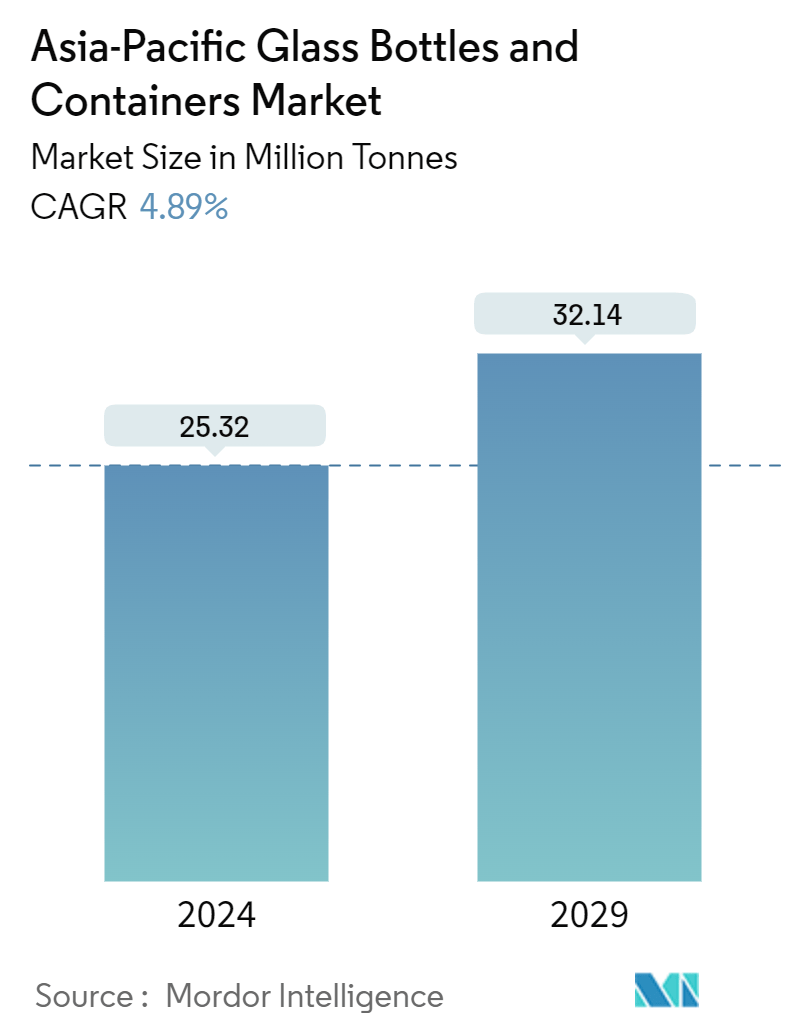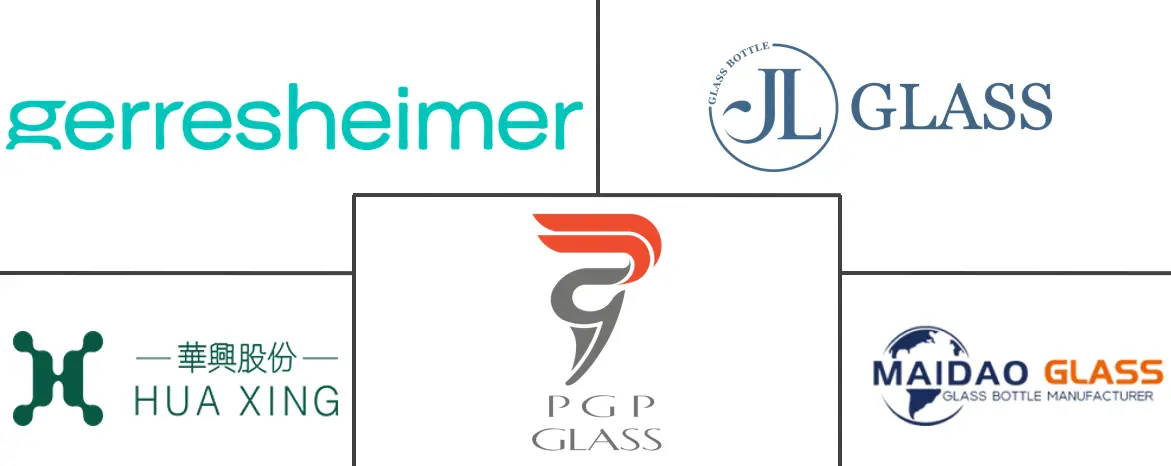| Study Period | 2019 - 2029 |
| Base Year For Estimation | 2023 |
| Forecast Data Period | 2024 - 2029 |
| Market Volume (2024) | 25.32 Million tonnes |
| Market Volume (2029) | 32.14 Million tonnes |
| CAGR | 4.89 % |
| Market Concentration | Low |
Major Players*Disclaimer: Major Players sorted in no particular order |
Asia-Pacific Container Glass Market Analysis
The Asia-Pacific Glass Bottles And Containers Market size is estimated at 25.32 Million tonnes in 2024, and is expected to reach 32.14 Million tonnes by 2029, at a CAGR of 4.89% during the forecast period (2024-2029).
- In the Asia-Pacific region, the food, beverage, and pharmaceutical sectors are driving a surge in demand for glass containers. This uptick is largely attributed to bans on plastic packaging, a push for sustainability, and a well-established recycling infrastructure throughout the region.
- Data from the International Trade Centre highlights China's dominance in Asia's glass container exports, tallying 1,898,260 tons in 2023, with India trailing at 357,747 tons. As both nations ramp up their export activities, they're poised to channel investments into cutting-edge production technologies. Such advancements promise not only superior product quality but also streamlined processes, potentially slashing costs and bolstering the competitiveness of glass containers against other packaging alternatives.
- In India, the rising appetite for alcoholic beverages is set to propel the glass container industry's expansion. Glass bottles, especially for wine, are favored for their protective qualities against sunlight-induced spoilage. Agriculture and Agri-Food Canada forecasts India's wine consumption to hit 52.2 million liters by 2025, further amplifying the demand for glass packaging.
- With the crackdown on single-use plastics, there's been a notable pivot towards alternatives like glass. In Japan, the financial outlay for recycling glass bottles stands out as more economical compared to other packaging materials. Data from the Japan Containers and Packaging Recycling Association reveals that in 2023, recycling costs for amber and colorless glass bottles were about JPY 8.2 (USD 0.058) and JPY 6 (USD 0.042) per kilogram, respectively. Such cost benefits are nudging manufacturers towards glass packaging.
- Producing glass is an energy-intensive endeavor, demanding elevated temperatures to melt raw materials. This energy requirement can inflate operational costs, particularly in areas grappling with surging energy prices or stringent environmental mandates. Moreover, fluctuations in the prices of key raw materials like silica, soda ash, and limestone can further escalate production expenses.
Asia-Pacific Container Glass Industry Segmentation
Container glass is used in the alcoholic and non-alcoholic beverage industries due to its ability to maintain chemical inertness, sterility, and non-permeability. Glass packaging is valued for its unique properties, including its transparency, inertness, and ability to preserve the quality and integrity of its contents. It is often chosen for products where purity, safety, and environmental sustainability are paramount concerns.
The Asia-Pacific container glass market is segmented by end-user vertical (beverages [alcoholic (wines and spirits, beer, and cider), non-alcoholic (carbonated soft drinks, juices, water, dairy-based, flavored drinks, etc.)] food, cosmetics, pharmaceuticals, and other end-user vertical) and country (China, India, Japan, Thailand, Australia and New Zealand, South Korea, Vietnam, Rest of Asia Pacific). The report offers market forecasts and size in volume (tonnes) for all the above segments.
| Bevarages | Alcoholic | Beer and Cider | |
| Wine and Spirits | |||
| Non-Alcoholic | Carbonated Soft Drinks | ||
| Juices | |||
| Water | |||
| Dairy Based Drinks | |||
| Flavored Drinks | |||
| Food | |||
| Cosmetics | |||
| Pharmaceutical (Excluding Vials and Ampoules) | |||
| Other End-User Vertical | |||
| China |
| India |
| Japan |
| Thailand |
| Australia and New Zealand |
| South Korea |
| Vietnam |
Asia-Pacific Glass Bottles And Containers Market Size Summary
The Asia-Pacific glass bottles and containers market is experiencing significant growth, driven by increasing demand in the food, beverage, and pharmaceutical sectors. The region's shift away from plastic packaging due to environmental concerns and the push for sustainability has bolstered the use of glass as a preferred packaging material. This trend is particularly evident in countries like India and China, where the rising consumption of alcoholic beverages and the expanding middle class are fueling demand for glass packaging. In China, the growing beverage market and changing consumer lifestyles are shaping the demand for glass containers, while in India, the preference for glass bottles in wine packaging is expected to drive market expansion. The ban on single-use plastics further accelerates the transition to glass, as it offers a sustainable and recyclable alternative.
The market is also witnessing innovation and strategic initiatives by major companies to enhance their product offerings and capture market share. Brands like Coca-Cola and PepsiCo are leading efforts to promote reusable glass bottles, aligning with global sustainability goals. The demand for functional and non-alcoholic beverages is also contributing to market growth, with glass packaging being favored for its safety and ability to preserve product integrity. Additionally, the market is semi-consolidated, with key players investing in strategic partnerships and product developments to strengthen their presence. Recent acquisitions and product launches, such as TricorBraun's expansion in Australia and SGD Pharma's eco-friendly glass bottles, highlight the dynamic nature of the market and the ongoing efforts to meet evolving consumer preferences and regulatory requirements.
Asia-Pacific Glass Bottles And Containers Market Size - Table of Contents
1. MARKET DYNAMICS
-
1.1 Market Drivers
- 1.1.1 Increased Demand for Sustainable Packaging Solutions Boosting Glass Use
- 1.1.2 Growing Pharmaceutical Industry Preference for Glass Packaging
-
1.2 Market Challenge
- 1.2.1 High Manufacturing and Energy Costs Limiting Growth in the Container Glass Market
- 1.3 Trade Scenerio - Analysis of the Historical and Current Export Import Paradigm for Container Glass Industry in Asia-Pacific
2. MARKET SEGMENTATION
-
2.1 By End-user Vertical
- 2.1.1 Bevarages
- 2.1.1.1 Alcoholic
- 2.1.1.1.1 Beer and Cider
- 2.1.1.1.2 Wine and Spirits
- 2.1.1.2 Non-Alcoholic
- 2.1.1.2.1 Carbonated Soft Drinks
- 2.1.1.2.2 Juices
- 2.1.1.2.3 Water
- 2.1.1.2.4 Dairy Based Drinks
- 2.1.1.2.5 Flavored Drinks
- 2.1.2 Food
- 2.1.3 Cosmetics
- 2.1.4 Pharmaceutical (Excluding Vials and Ampoules)
- 2.1.5 Other End-User Vertical
-
2.2 By Country
- 2.2.1 China
- 2.2.2 India
- 2.2.3 Japan
- 2.2.4 Thailand
- 2.2.5 Australia and New Zealand
- 2.2.6 South Korea
- 2.2.7 Vietnam
Asia-Pacific Glass Bottles And Containers Market Research FAQs
How big is the Asia-Pacific Glass Bottles And Containers Market?
The Asia-Pacific Glass Bottles And Containers Market size is expected to reach 26.56 million tonnes in 2025 and grow at a CAGR of 4.89% to reach 33.72 million tonnes by 2030.
What is the current Asia-Pacific Glass Bottles And Containers Market size?
In 2025, the Asia-Pacific Glass Bottles And Containers Market size is expected to reach 26.56 million tonnes.




